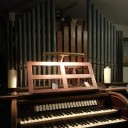For those wondering what OMNI is, here is a link to Dropbox for
a screen shot.
https://www.dropbox.com/s/m5egmmxi1o85…screen.JPG?dl=0
OMNI screen shot.
-
-
If you're willing to help Beta test the Omni set, please send me a personal message on this forum.
Kind regards,
GrahamG -
A short legal review:
* Pitea, Kalvträsk, Burea are CC BY-SA. So modification+redistribution are OK.
* Barton is CC BY-NC-SA. Non-commercial modification+redistribution are OK.
* One stop seems to be Jeuxdorgues2. While everybody can download it, there is no license statement We would need the permission of Joseph or drop that stop.
* ODF is OK and states, its CC BY-SA [based on work by Lars & Graham]
* A few simple images for the console are included.CC BY-SA and CC BY-NC-SA are not compatible (https://wiki.creativecommons.org/wiki/File:CC_L…ility_Chart.png). Distributing the sampleset (without the Jeuxdeorgues stop) in two files splitted by their license (CC BY-SA, CC BY-NC-SA) should be save to distribute, as the user (and not we) combine both licenses.
-
* The enclosures should have a MouseAxisStart/MouseAxisEnd, as the axis of the swell shoe is not in the middle.
* If you want more generals, copy the [SetterElement001] block to SetterElement025, SetterElement026, and so on. Increment NumberOfSetterElements accordingly. Change Type to General11, General12, (up to 50 is possible) and set DispLabelText to your intented label. You need to adapt PositionX and PositionY, until the location of the button is suitable for you.
* The sequencer works in my option as intended. Could you please explain, what do you mean "But if you move to the next decade, it overwrites, etc." and what other combination bugs occure.
* Why do you adjust the gain/amplitudes so, that it works with a volume -75dB [GO will load a organ with a volume of -15 dB by default].
* I would call a few stops as nearly non-audible. What is the reason for them? -
This is simple. There are 10 pistons. What you call the sequencer is 100 memory banks of 10.
When you set registrations for 10 pistons in memory 1-10, and then advance to the next 10
(11-20) or the next decade bank, the first bank 1-10 is overwritten. So maybe in fact the other
99 memory banks of 10 don't exist, or there is an error in the odf. You have to check if the combinations remain intact. Your testing is faulty. This is supposed to be an exact copy of the floating panel which does work. But this built-in version does not. The ABC memory banks do work exactly as I describe, but there are only 10. The same piston and memory bank arrangement that works on the extended AGO version of Burea church. THE MEMORY BANKS NEED TO WORK.
The overall gain adjustment, at least on my equipment, has to be set at -75, because with 70% of the organ playing, the summing buss or overall gain indicator will overload and the sound will distort.
You will notice that the voicing for most of the stops has been increased, while the overall gain has been
decreased. It seems to act like a water pipe. The larger the pipe, the more combined sound can pass. OMNI is a very large VPO, and it has just worked out this way. If you can figure another way to lower distortion, it would be nice.The enclosures work just fine, but I would rather have a thermometer type like Graham's Barton organ.
This organ requires a principal 32', so someone should gain the permission to use, or find or make a substitution.
-
You confuse the GO combinations functions.
GO features two totally INDEPENDENT combination systems:
a) A 1000 step sequencer. This is controlled by the "100" "10" "<" ">" "10" "100" buttons.
b) 10 banks a 10 (50 on the extended panel) generals. This is controlled by the "G1" - "G10" "+" "-" buttons.You must keep in mind, that pressing any button of a) does not affect b) [and the other way around].
a) has also direct access buttons (named __0 to __9) on the sequencer panel, which could be also added to the main panel.
Burea AGO is very old - so old, that at that time GO only supported not-banked generals.
It is better to reduce the gain at organ level [Gain option in [Organ] section]. This should give you the same result and is permanent.
That organ would be a good candidate for using more than 2 output channels. That way, you could use higher volumes for the various stops.
The enclosures are mouse controlable, but if you move the pressed mouse cursor over the enclosue, it will behave not very logical. If you move the axis down, the move of the swell pedal will follow the cursor.
-
- Offizieller Beitrag
Everybody should try OMNI I haven't heard form Mikelectric whether he is interested in posting to this website because of the mechanics involved.
Yes, I´m always interested in such things. If it is all legal, then I can add it to the download area.Zitat
A pretty big file. He or some others should test it out first.
This is a large multi-purpose organ. It fills a very big gap between
all the small, mostly baroque organs that are available.
How many GB? I think our server should be able to host it. Are the samples modified? If original, we can just offer the ODF and link to the web sites of the needed sample sets.If you wish, I can help testing OMNI.
Regards
Michael
-
Hi,
In regard to creating a license agreement for this conglomerate, I will contact Joseph Basquin regarding the 32' from the Jeuxdorgues2.
I think we should also approach Lars to see if we can release the Pitea, Kalvträsk, and Burea ranks as CC BY-NC-SA, Non-commercial. Most users will not be interested in downloading six sample sets and then trying to copy the correct ranks into a folder in order to use the Omni. It would be much easier to release it as a single package.
I was also unaware of the distinction between the two systems of combinations, I had thought that it was one system. So we'll need to fix the .organ definition in order to get the behavior that Ken wants for the combinations.
Kind regards,
GrahamG -
Yes, big file, about 6-7 gigs unzipped. But worth it.
Even an organ half this size with Hauptwerk is bigger.
It will load and play in full on 8 gigs RAMMikelectric, please give it a look and help this along.
Ken -
The organ is about 1.7 GB compressed.
GO supports wavpack compressed samples. While the size of the cache file will not shrink, the extracted samples should take about the same size as currently the rar file.
PS: Can't we talk to Barton author about CC BY-SA?
-
- Offizieller Beitrag
Thank you for giving the link to the Omni set.
I've tried it a little. My first impressions are as follows:
- 1,7 GB compressed - absolutely no problem to host it on our server
- the samples seems to have the quality standard of HW1 era
- no multi release samples
- quite different acoustics of different recordings
- very different volume levels between the stops
- a number of similar stops in the divisions
- some ranks are not sorted correct into C- and C sharp compartment
- fits also into smaller amounts of RAMSo it is not in line with the current standards of sample sets.
Nevertheless, I would be happy if there is available a large, complimentary set for GO, like this one.Possibly the sound would be more adequate for an organ of this size, if truncating the samples and adding IR reverb.
-

Mikelectric
5. Januar 2019 um 15:52 Hat das Thema aus dem Forum English nach GrandOrgue English verschoben. -

Mikelectric
15. Januar 2022 um 00:24 Hat das Thema aus dem Forum GrandOrgue English nach GrandOrgue verschoben.

